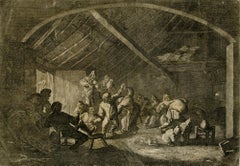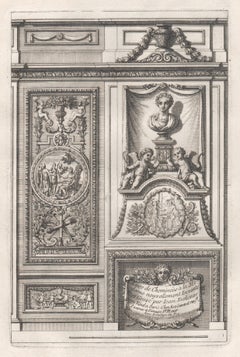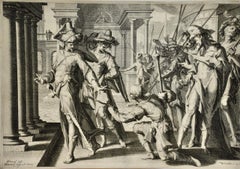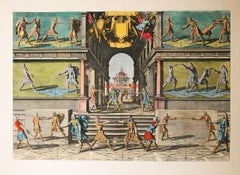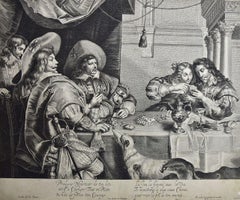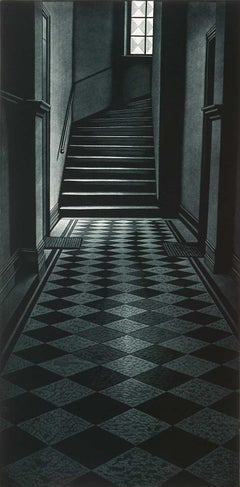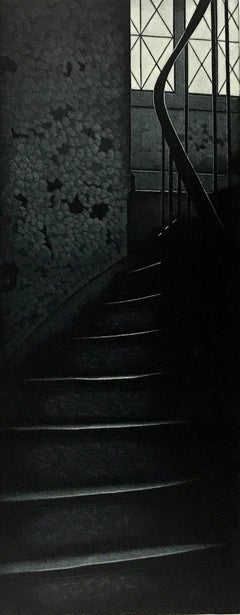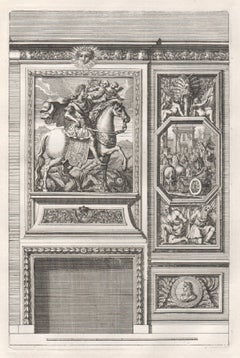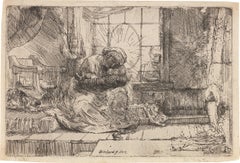17th Century Interior Prints
to
2
8
1
3
1
1
Overall Width
to
Overall Height
to
6
1
3
1
1
1
1
127
223
1,111
771
11
13
21
53
35
84
86
212
249
85
104
9
5
9
5
4
4
3
2
1
1
1
1
1
1
1
8
6
2
1
1
3
6
9
4
Period: 17th Century
Farmers enjoying a barn dance with a violinist and a bagpiper.
Located in Middletown, NY
Etching on cream laid paper mounted to a cream laid paper support, 9 x 12 7/8 inches (230 x 327 mm), thread margins. Three small areas of light skinning with one extremely small hole...
Category
Old Masters 17th Century Interior Prints
Materials
Etching, Laid Paper
Four French Louis XIV period chimney-piece design engravings by Jean Dolivar
Located in Melbourne, Victoria
'Luire de Cheminees a la Moderne nouvellement Invente et Grave par Jean Dolivar.'
Collection of 4 engravings with designs for chimney-pieces. Published in Paris, circa 1670.
210mm ...
Category
Baroque 17th Century Interior Prints
Materials
Engraving, Etching
Jan Oytenbogaert
Located in San Francisco, CA
This artwork titled Jan Uytenbogaert" 1639 is an etching on paper After Rembrandt Van Rijn, 1606-1669, plate engraved By French renown engraver Charles Armand Durand, 1831-1905. Sign...
Category
Realist 17th Century Interior Prints
Materials
Etching
"Allegory of Justice": A 17th Century Old Master Engraving by van Swanenburg
By Willem van Swanenburg
Located in Alamo, CA
This old master engraving entitled "Allegorie op de Rechtspraak" is by Willem van Swaanenburg after a painting by Joachim Wtewael, published by Ch...
Category
Old Masters 17th Century Interior Prints
Materials
Engraving
Academie de l’Espee Tabula 2 prints Girarld Thibault Tab. XXXIII & Tab.IIII
Located in Paonia, CO
Two hand colored engravings from the Academie de l’Espee ( full title can be translated as Academy of the Sword: wherein is demonstrated by mathematical rules on the foundation of a mysterious circle the theory and practice of the true and heretofore unknown secrets of handling arms on foot and horseback ) by Girard Thibault...
Category
Other Art Style 17th Century Interior Prints
Materials
Engraving
The Card Game: An Early 17th Century Engraving by A. Voet after Cornelis de Vos
By Alexander Voet
Located in Alamo, CA
A 17th century engraving entitled "The Card Game" by old master artist Alexander de Voet after a painting by Cornelis de Vos, created in 1632. The pain...
Category
Old Masters 17th Century Interior Prints
Materials
Engraving
Van Ostade, Le Gourmet en compagnie, c.1664
Located in Torino, IT
ADRIAEN VAN OSTADE, Haarlem 1610 - 1684
Le Gourmet en compagnie, 1664 c.a
Original etching and drypoint, signed in plate at lower left.
Bibliography: Godefroy 50 VII/XII. (mm. 219x2...
Category
Old Masters 17th Century Interior Prints
Materials
Etching
The Duchess of St. Albans: A 17th C. Portrait After a Kneller Painting
By (After) Sir Godfrey Kneller
Located in Alamo, CA
This is a 17th century engraved mezzotint portrait of the Duchess of St. Albans by John Smith, after a painting by Sir Godfrey Kneller. It was published in London by John Boydell in 1694.
The Duchess of St. Albans (1642-1712) was a woman named Diana de Vere. She was born in 1642, the daughter of Aubrey de Vere, the 20th Earl of Oxford. In 1662, she married Charles Beauclerk, the illegitimate son of King Charles II and his mistress, Nell Gwyn. As a result of her marriage, Diana became the Duchess of St. Albans, and she and Charles had several children together. Diana was known for her beauty and charm, and she was a prominent figure in the court of King Charles II. Despite her husband's illegitimate birth, Diana was highly respected in the royal court and was known for her intelligence and wit. She was a patron of the arts and supported many artists and writers of the time. Diana lived through a tumultuous period of English history, including the Great Fire of London and the Glorious Revolution, which saw King James II replaced by William of Orange. She died in 1712 at the age of 70 and was buried in Westminster Abbey. Descendants of Diana and her husband, who was an illegitimate son of King Charles II, include Diana, Princess of Wales and her son William, Duke of Cambridge.
An author wrote of her: "The line of Vere, so long renown’d in arms,
Concludes with luster in St. Albans’s charms;
Her conquering eyes have made their race complete,
It rose in valor, and in beauty set."
This striking mezzotint engraving depicts Diana, Duchess of St Albans in a three-quarter length pose, standing, wearing loose flowing dress and a wrap. She has a very serene, calm appearance as she is looking straight at the viewer. There is a landscape of trees in the background. The print is adhered in the corners to an archival backing, which is itself adhered in the upper corners to a larger backing. The print is trimmed to just beyond the plate mark. There are areas of discoloration in the margins and in the inscription area, but the print is otherwise in very good condition. The sheet measures 14.5" high and 10" wide. This mezzotint is held by multiple museums and institutions, including The British Museum, The National Portrait Gallery London, The Fine Arts Museum of Boston, The Lewis Walpole Library at Yale, The Yale Center for British Art, The Fitzwilliam Museum at Cambridge and The National Galleries of Scotland. The original Kneller painting is part of the British Royal Collection Trust and hangs in the King's Private Dining Room at Hampton Court Palace.
Sir Godfrey Kneller (1646-1723) was a leading portrait painter of his time, particularly renowned for his depictions of the British aristocracy and royalty. He was born in Lübeck, Germany, and trained in Amsterdam under the painter Ferdinand Bol...
Category
17th Century Interior Prints
Materials
Mezzotint
The Peasant Settling His Debt
Located in Middletown, NY
Etching on thin, cream laid paper 4 x 3 5/8 inches (100 x 90 mm), with narrow margins, trimmed inside the platemark. Adhesive residue at the top right and left corners, and archival ...
Category
Old Masters 17th Century Interior Prints
Materials
Etching
N. Lambert Seigneur de Thorigny: 17th C. Engraved Portrait After Largillière
Located in Alamo, CA
This is a 17th century engraving entitled "Messire Nicolas Lambert Seigneur de Thorigny, Conseiller du Roy" by Pierre Drevet after a painting by Noicolas de Largillière, published in Paris in 1698. This portrait depicts a three-quarter length view of Nicolas Lambert de Thorigny, who is dressed in elaborate robes and collar of a wealthy Parisian nobleman of the time. He is seated directed to the left and looking directly at the viewer. He is holding an inscribed note in his right hand. A magnificent billowing curtain is in the background. Lambert's coat of arms is shown in the center of the lower inscription area. In the inscription area is lettered with title, production detail: "Nic. Largilliere pinxit" and "Petr. Drevet sculpsit", and publication detail: "Se vend a Paris chez Drevet rüe du Foin au coin du College de Maître Gervais".
Nicolas Lambert, Seigneur de Thorigny (1600-1664), was a French nobleman and military commander who lived in the 17th century. He served in the French army during the Thirty Years' War, a conflict that took place from 1618 to 1648 and involved many European powers. Lambert fought in several battles during the war and rose to the rank of colonel. After the war, Lambert returned to France and became involved in politics. He served as a member of the Estates General, a legislative body that advised the king, and as a governor of several provinces. He was a counsellor and confidant of King Louis XIV. He had the title of Président de la Chambre des Comptes. He also became a member of the French Academy of Sciences, a prestigious institution that promotes scientific research and scholarship. Lambert was known for his military expertise, his intelligence, and his commitment to public service. He iInherited the Hôtel Lambert in Paris from his brother Jean Baptiste in 1644 and hired some of the most prominent artists of the time, including Charles Le Brun to decorate and furnish the building.
This beautiful old master engraving was created with impressive detailed technique. It is printed on laid, chain-linked paper. The sheet measures 18.5" high and 13.38" wide. The sheet is adhered to an archival backing paper at the top. There is a faint horizontal center fold and mild discoloration in the inscription area and in the upper margin on the right, with mild wrinkling here. The print is otherwise in very good condition, considering its age. This engraving is so rare, that no comparable prints could be identified for sale online. It is currently only listed in museum collections, including: The Metropolitan Museum of Art, The British Museum, The Louvre, The Riksmuseum, The Victoria & Albert Museum, The Fitzwilliam Museum at the U. of Cambridge, The Boston Museum of Fine Arts, Harvard Art Museums, The Finnish National Museum, The Philadelphia Museum. It is shown in the Metropolitan Museum's Cataloque of French paintings entitled: "French Paintings in The Metropolitan Museum of Art, published in 2018, page 36. The page is included in the photos.
Nicolas de Largillière (1656-1746) was a French portrait painter who achieved great success and acclaim during the late Baroque and Rococo periods. He was born in Paris and trained under the painter Antoine Goubeau. He studied in Antwerp and London before returning to France. While in England he was a favorite painter of King Charles II and King James II of England...
Category
17th Century Interior Prints
Materials
Engraving
Interior Meeting - Original Etching by Cornelis Meyssens - 17th Century
Located in Roma, IT
Interior Meeting is an original etching realized by Cornelis Meyssens ( 1640-1573).
Good conditions, except for some foldings.
Included a Passepartout: 34 x 49 cm
The artwork repres...
Category
Baroque 17th Century Interior Prints
Materials
Etching
The Heidelberg Tun: A Framed 17th Century Engraving of a Huge Wine Cask
Located in Alamo, CA
"The Heidelberg Tun" is a 17th century engraving by an unknown artist. It depicts a famous huge ornamental wine cask that resided in the wine cellar of Heidelberg Castle. The cask shown here, built in 1664, is the second of four Heidelberg Tuns; the first was destroyed during the Thirty Years' War, between 1618 and 1648. This cask was built in 1664 when Karl Ludwig ordered Heidelberg cellar master...
Category
Old Masters 17th Century Interior Prints
Materials
Engraving
In a tavern. Paper, engraving, 21x25 cm
Located in Riga, LV
In a tavern.
engraver Jan De Visscher (1933-1692)
Paper, engraving, 21x25 cm
Category
Realist 17th Century Interior Prints
Materials
Paper, Engraving
$1,378 Sale Price
20% Off
Entablature II, from Entablature Series
Located in London, GB
Screenprint in colours with embossing and collage of gloss copper and mat pink metallic foil, 1976, on Rives BFK paper, signed and dated in pencil, numbered from edition of 30 (there...
Category
American Modern 17th Century Interior Prints
Materials
Screen
Related Items
Days Gone
Located in New Orleans, LA
Finns always seek the solace of nature. Is this mysterious stairway an escape from the challenges of civilization? Vanttinen created this mezzotint in an edition of 100 and it is tit...
Category
Contemporary 17th Century Interior Prints
Materials
Mezzotint
Before It Happened (A mysterious staircase offers no clues as to what happened)
Located in New Orleans, LA
This Finnish artist creates a mezzotint in black and white. This impression is #44 of 100 and is signed, dated and titled in pencil.
Jukka Vanttinen (Finn, b. 1954)
Jukka Vanttinen...
Category
Modern 17th Century Interior Prints
Materials
Mezzotint
Jukka VanttinenBefore It Happened (A mysterious staircase offers no clues as to what happened), 2005
$375 Sale Price
25% Off
H 21.38 in W 8.5 in
"King of the Friendly Islands" (Tonga); Engraving from Captain Cook's 3rd Voyage
By John Webber
Located in Alamo, CA
"Poulaho, King of the Friendly Islands, Drinking Kava" is an engraving created by William Sharp (1749-1824), from a drawing by John Webber (1752-1793), who was the artist on Captain James Cook's 3rd and final voyage of discovery. It was published in the atlas of "A Voyage to the Pacific Ocean Undertaken by the Command of His Majesty, for Making Discoveries in the Northern Hemisphere", the official British Admirality sanctioned journal published upon completion of the voyage in London in 1784 by Strahan & Cadell.
Captain Cook visited Tonga on his 3rd voyage, which he named The Friendly Islands because of the warm welcome he and his crew received, unlike some of the other more hostile Pacific islands. The engraving depicts Cook and his men observed a kava ceremony at the village of Mu’a on Tongatapu. King Paulaho sits in the centre foreground, his back to the spectator with a man kneeling before him. The ceremonial mat depicted behind Paulaho indicates that nobody was allowed to sit behind him. The figure in the centre holds a single cup, referring to the Tongan custom of offering the cup to the king first. Kava is native to the islands of the South Pacific and was first described for English readers in 1768 by Captain James Cook. The kava root has been used for centuries as a central feature of ceremonies and celebrations because it was able to bring about a calming and pleasant social atmosphere. The root was crushed and processed into coconut milk to become the focal ceremonial beverage, simply referred to as kava.
This engraving is presented in a Koa wood frame and a white mat. Koa wood is legendary in Hawaii. There are occasional faint spots, but the print is otherwise in very good condition. This amazing Koa wood is native to Hawaii and it is known for the deep rich colors and varied grain pattern. Koa has an honored heritage in Hawaii and is highly revered and sacred. The word “koa” means “warrior” in Hawaiian. The warriors of King Kamehameha the Great, created canoes and weapons from a wood plentiful on the Big Island of Hawaii. This wood became synonymous with the warriors themselves, and it became known as koa.
There are three other engravings listed from the official journal of Captain Cook's 3rd voyage available that are presented in identical Koa wood frames and mats (LU117324682422, LU117324684052, LU117324684032). They would make a wonderful grouping for a display of 2, 3 or 4 prints. A discount is available for a grouping depending on the number of items included.
Captain Cook is remembered as one of the greatest explorers and navigators in history. His explorations included Australia, New Zealand and islands of the South Pacific and the northwest coast of North America. Hawaii was discovered by Captain Cook during this voyage. Hawaii was originally called The Sandwich Islands in honor of The Earl of Sandwich...
Category
Realist 17th Century Interior Prints
Materials
Engraving
$2,375
H 18.25 in W 23.5 in D 0.88 in
Don Juan
By Louis Icart
Located in Missouri, MO
Aquating Engraving
Image Size: approx. 20 1/4 x 13 3/8
Framed Size: 28 x 20.5 inches
Pencil Signed Lower Right
Louis Justin Laurent Icart was born in Toulouse in 1890 and died in Paris in 1950. He lived in New York City in the 1920s, where he became known for his Art-Deco color etchings of glamourous women.
He was first son of Jean and Elisabeth Icart and was officially named Louis Justin Laurent Icart. The use of his initials L.I. would be sufficient in this household. Therefore, from the moment of his birth he was dubbed 'Helli'. The Icart family lived modestly in a small brick home on rue Traversière-de-la-balance, in the culturally rich Southern French city of Toulouse, which was the home of many prominent writers and artists, the most famous being Henri de Toulouse-Lautrec.
Icart entered the l'Ecole Superieure de Commerce de Toulouse in order to continue his studies for a career in business, particularly banking (his father's profession). However, he soon discovered the play writings of Victor Hugo (1802-1885), which were to change the course of his life. Icart borrowed whatever books he could find by Hugo at the Toulouse library, devouring the tales, rich in both romantic imagery and the dilemmas of the human condition. It was through Icart's love of the theater that he developed a taste for all the arts, though the urge to paint was not as yet as strong for him as the urge to act.
It was not until his move to Paris in 1907 that Icart would concentrate on painting, drawing and the production of countless beautiful etchings, which have served (more than the other mediums) to indelibly preserve his name in twentieth century art history.
Art Deco, a term coined at the 1925 Paris Exposition des Arts Decoratifs, had taken its grip on the Paris of the 1920s. By the late 1920s Icart, working for both publications and major fashion and design studios, had become very successful, both artistically and financially. His etchings reached their height of brilliance in this era of Art Deco, and Icart had become the symbol of the epoch. Yet, although Icart has created for us a picture of Paris and New York life in the 1920s and 1930s, he worked in his own style, derived principally from the study of eighteenth-century French masters such as Jean Antoine Watteau, François Boucher and Jean Honoré Fragonard.
In Icart's drawings, one sees the Impressionists Degas...
Category
Art Deco 17th Century Interior Prints
Materials
Engraving, Aquatint
Church of St. Costanza, Rome: An 18th Century Piranesi Architectural Etching
Located in Alamo, CA
This is a framed 18th century Giovanni Battista Piranesi etching entitled: "Veduta interna del Sepocro di Santa Costanza, fabbricat...
Category
Old Masters 17th Century Interior Prints
Materials
Etching
$3,775
H 27 in W 32 in D 1.5 in
Original AJANTA INDIA Bodhisattva Padmapani vintage travel poster 1959
Located in Spokane, WA
Original Ajanta India vintage travel poster from 1959. Archival linen backed in Grade A condition, ready to frame. Note that a later edition of this poster was printed but the im...
Category
Old Masters 17th Century Interior Prints
Materials
Lithograph
$995
H 39.5 in W 24.25 in D 0.3 in
Annual Events for Young Murasaki (July) - Tales of Genji - Japanese Woodblock
Located in Soquel, CA
Annual Events for Young Murasaki (July) - Tales of Genji - Japanese Woodblock
Rightmost panel a triptych, depicting monthly events for Wakamurasaki (Young Murasaki). This is the month of July. There appears to be a lesson taking place, possibly for writing or poetry.
Artist: Toyokuni III/Kunisada (1786 - 1864)
Publisher: Ebisu-ya Shoshichist
Presented in a new blue mat.
Mat size: 19"H x 13"W
Paper size: 14.5"H x 10"W
Commentary on the triptych:
In the Edo period, Tanabata was designated as one of the five seasonal festivals, and became an annual event for the imperial court, aristocrats, and samurai families, and gradually came to be celebrated by the general public. Its origins are said to be a combination of the Kikoden festival, which originated from the Chinese legend of Altair and the Weaver Girl, and Japan's ancient Tanabata women's faith. Ink is ground with dew that has accumulated on potato leaves, poems and wishes are written on five colored strips of paper, which are then hung on bamboo branches to celebrate the two stars that meet once a year. Although the illustration is a Genji painting...
Category
Realist 17th Century Interior Prints
Materials
Printer's Ink, Rice Paper, Woodcut
$682 Sale Price
30% Off
H 19 in W 13 in D 0.25 in
Kumasaka Chōhan to Ushiwakamaru - One of a Diptych Original Woodcut Print
Located in Soquel, CA
Kumasaka Chōhan to Ushiwakamaru is a Japanese Ukiyo-e print created between 1848 and 1854 by artist Utagawa Kunisada (Japanese, 1786-1864). The print is a Diptych, and is part of the...
Category
Realist 17th Century Interior Prints
Materials
Printer's Ink, Rice Paper, Woodcut
$880 Sale Price
20% Off
H 18.5 in W 13.68 in D 0.38 in
Ichimura Uzaemon XIII - actor as Okaji of Gion, 1862 "The Six Poetry Immortals"
Located in Soquel, CA
Ichimura Uzaemon XIII - actor as Okaji of Gion, 1862 "The Six Poetry Immortals"
A Japanese Ukiyo-e woodcut print created circa 1862 by artist Utagawa Kunisada (Japanese, 1786-1864). ...
Category
Realist 17th Century Interior Prints
Materials
Printer's Ink, Rice Paper, Woodcut
$680 Sale Price
20% Off
H 21.75 in W 16.75 in D 1.25 in
The Roman Colosseum: A Framed 18th Century Etching of the Interior by Piranesi
Located in Alamo, CA
This large framed 18th century etching by Giovanni Battista Piranesi entitled "Veduta dell'interno dell'Anfiteatro Flavio detto il Colosseo" (View of the interior of the Flavian Amph...
Category
Old Masters 17th Century Interior Prints
Materials
Etching
$5,875
H 28.88 in W 37.25 in D 1.25 in
A Framed 18th C. Piranesi Etching of an Ancient Marble Vase from Hadrian's Villa
Located in Alamo, CA
This large framed 18th century etching by Giovanni Battista Piranesi is entitled "Vaso antico di Marmo adornato di eccellenti Sculture si nella parte anteriere che nell' opposta, le ...
Category
Old Masters 17th Century Interior Prints
Materials
Etching
$3,975
H 42.25 in W 26.5 in D 1.5 in
Interiors VI: Soundings
By Peter Milton
Located in New York, NY
Contemporary artist Peter Milton created this etching and engraving entitled "Interiors VI: Soundings" in 1989. The printed image size is 29 7/8 x 23 13/16 and paper size is 36 x 29 inches. This impression is signed, dated, and titled in pencil and inscribed “93/175” – the 93 impression of 175.
“I do love to draw. I feel that I am being granted membership in the Brotherhood of Merlin, conjuring forth some apparition. As a drawing develops, I sense a vague presence coming more and more into focus, something in a white fog emerging and becoming increasingly palpable.” – P. Milton, “The primacy of touch. The Drawings of Peter Milton”
“Working in layers, Milton begins with drawings based on people and places, with nods to Western art history and culture. He is a master of the appropriated image, a term that may conjure Andy Warhol and his Pop Art comrades. But Milton steps further back in history, avoiding the Pop sense of cool advertising and popular culture references. Instead, a broader cultural past is tapped through historical photographs of key players, architecture, and locales, which he reinvents by hand. He adds content drawn from his life as an avid reader – always with multiple possible interpretations – thus incorporating deeper meaning in his cinematic worlds. Elements of Greek mythology, classical music, art history, and history coalesce in his images, which embrace the messiness, sorrow, and elation that is life. One is hard-pressed to imagine a more erudite, skilled, passionate, and cheeky soul."
– T. L. Johnson and A. Shafer
Peter Milton was born in Pennsylvania in 1930. He studied for two years at the Virginia Military Institute...
Category
Surrealist 17th Century Interior Prints
Materials
Engraving, Etching
Previously Available Items
Two French Louis XIV period chimney-piece design engravings by Jean Dolivar
Located in Melbourne, Victoria
'Luire de Cheminees a la Moderne nouvellement Invente et Grave par Jean Dolivar.'
Two engravings with designs for chimney-pieces. Published in Paris, circa 1670.
210mm by 140mm (pl...
Category
Baroque 17th Century Interior Prints
Materials
Etching, Engraving
The Virgin And Child With The Cat And The Snake By Rembrandt Van Rijn
Located in New Orleans, LA
Rembrandt van Rijn
1606-1669 Dutch
The Virgin and Child with the Cat and the Snake
Etching laid on paper
New Hollstein's first state of IV
Signed and dated "Rembrandt. f. 1654" (u...
Category
Old Masters 17th Century Interior Prints
Materials
Laid Paper, Etching
H 20.25 in W 16.25 in D 0.75 in
Huitzilopochtli, Aztec God of War, Lithograph from "Description de L'Universe"
Located in Soquel, CA
Huitzilopochtli, Aztec God of War, Lithograph from "Description de L'Universe"
Detailed etching by Alain Manesson Mallet (French, 1630–1706). This page from Mallet's famous book sho...
Category
Gothic 17th Century Interior Prints
Materials
Paper, Ink, Lithograph
H 14.5 in W 12.5 in D 1.25 in
Temple of Baalbec, Lebanon, 2 Roman architectural engravings, Jean Marot
By Jean Marot
Located in Melbourne, Victoria
'Coupe et profil du dedans du Temple de Balbec'
Engraving by Jean Marot.
Jean Marot was a French architect, designer and engraver.
Baalbek is a town in the Bekaa valley in Lebano...
Category
Baroque 17th Century Interior Prints
Materials
Engraving, Etching
Temple of Baalbec, Lebanon, Classical Roman architectural engraving, Jean Marot
By Jean Marot
Located in Melbourne, Victoria
'Profil et Coupe generale du cote du Temple de Balbec'
Engraving by Jean Marot.
Jean Marot was a French architect, designer and engraver.
Baalbek is a town in the Bekaa valley in...
Category
Baroque 17th Century Interior Prints
Materials
Engraving, Etching
Temple of Baalbec, Lebanon, Classical Roman architectural engraving, Jean Marot
By Jean Marot
Located in Melbourne, Victoria
'Coupe et profil du dedans du Temple de Balbec, par le cote'
Engraving by Jean Marot.
Jean Marot was a French architect, designer and engraver.
Baalbek is a town in the Bekaa val...
Category
Baroque 17th Century Interior Prints
Materials
Engraving, Etching
Temple of Baalbec, Lebanon, Classical Roman architectural engraving, Jean Marot
By Jean Marot
Located in Melbourne, Victoria
'Coupe du Portrait du Temple de Balbec'
Engraving by Jean Marot.
Jean Marot was a French architect, designer and engraver.
Baalbek is a town in the Bekaa valley in Lebanon. It is...
Category
Baroque 17th Century Interior Prints
Materials
Engraving, Etching
Academie de l’Espee Tabula 2 prints Girarld Thibault Tab. XXXIII & Tab.IIII
Located in Paonia, CO
Two hand colored engravings from the Academie de l’Espee ( full title can be translated as Academy of the Sword: wherein is demonstrated by mathematical rules on the foundation of a mysterious circle the theory and practice of the true and heretofore unknown secrets of handling arms on foot and horseback ) by Girard Thibault...
Category
Other Art Style 17th Century Interior Prints
Materials
Engraving
Christ Driving the Money Changers from the Temple
Located in Fairlawn, OH
Signed in the plate lower right
A rich impression printed with some burr and plate tone in the shadows of the figures to the right
Watermark: Ash & Fletcher, Arms of Amsterdam D.c. presumed after 1650
Thought to be a slightly posthumous impression, with alterations in the plate not by Rembrandt.
Reference: Hind 126 ii/II, Bartsch 69 ii/II, New Hollstein 139 ii/IV
Before the retouching of plate and the posthumous editions by Watelet, Basan and Bernard
Note: MMA has a similar impression ii/II that compares very closely with this impression as does the Achenbach Foundation at the Fine Arts Museums of San Francisco and the Morgan Library.
The National Gallery of Art, Washington has a superior impression of ii/II (as here) with selective inking to achieve dramatic painterly effect.
According to Clifford Ackley in Rembrandt’s Journey Painter Draftsman Etcher, MFA Boston,
“Christ Driving the Money Changer from the Temple is perhaps the most physically energetic episode in Christ’s ministry. Christ’s cleaning the place of worship of those who seek to profit from religion is recounted by all four evangelists (see for example, John 2:13-16. Jesus made himself a flail of rope and wielded it vigorously to drive from the temple the moneychangers and those who sold cattle, sheep and doves for sacrificial offerings. Overturning the tables of the moneychangers, he declares that “My house shall be called the House of Prayer, but ye have made it a Den of Theives” (Luke 19:46).
The figure of Christ is one of Rembrandt’s most blatant creative borrowings. It is a reverse copy of the figure of Christ from the Albrecht Durer print...
Category
Old Masters 17th Century Interior Prints
Materials
Etching
The Death of the Virgin - Original Etching by Rembrandt - 1639
Located in Roma, IT
The Death of the Virgin is an etching with drypoint tweaks on wire rod double filigree paper, realized in 1639 by Rembrandt Harmenszoon van Rijn (Leiden, 1606 - Amsterdam, 1669).
Probable specimen of III state on three (according to White & Boon), IV on four (following Biörklund-Barnard).
Signature and date on plate on the lower left corner “Rembrandt f. 1639".
The paper has a cluster watermark with symmetrical elements in the center (similar to Ash Grapes B.a.) and a second watermark written on 4 lines (perhaps identifiable with Ash Words C.a.).
Superb specimen on doubly watermarked paper: the first on four lines dating back to around 1764 and widely diffused in Normandy and Germany; the second, clustered, traced back to the second decade of the 17th century. Sheet characterized by a legible and appreciable impression for the chiaroscuro; good conditions of conservation, even though some thinning is reported, in particular along the left margin and on the lower left corner, together with small gaps visible on the back and a superficial deposit of particles.
Reference:
Gersaint 1751, p. 71, n. 97; Bartsch 99; Hind 1924, n. 161; Biörklund-Barnard 1957, n. 39, IV; New Hollstein (Dutch & Flemish), n. 173 (Rembrandt); Hinterding et al. 2000 n. 32.III; White & Boon 1969, n. 99.III.
One of the most interesting works with a religious subject by the great old master, for both the compositional freedom and the technical expertise. We do not know who the customer was; it could have been a Catholic client, but this hypothesis seems to be at least doubtful precisely because of the peculiarity with which the episode is narrated. Certainly, this artwork is linked to a precise market request, given its size - this is the second largest incision of the artist - and the commitment to such an important work.
A more detailed description of this religious event is described particularly well in the Legenda Aurea by Jacopo da Varagine, a guiding text in the Middle Ages for all the artists who wanted to portray the Death of the Virgin: an angel appeared to Mary announcing her imminent death. It is told that the Apostles, dispersed in the four corners of the world to proclaim the Gospel, were miraculously transported to Mount Zion to be near them.
Disagreeing with other exegetes, Hinterding claims that Rembrandt knew the Legenda but was inspired by it in an original way, combining two moments in a single choral scene. Indeed, the scene depicted by the artist takes place in the bedroom of the Virgin: the angel appears at the top, accompanied by the cherubs, while the Apostles gather around her bed. For this marvelous etching, in addition to the aforementioned text by the Dominican friar da Varagine, Rembrandt certainly also looked at two fundamental works (to understand the genesis of the composition): the Death of the Virgin by Albrecht Dürer, from the silographic series of the Life of the Virgin, of which he owned a specimen, perhaps bought at auction in 1638, and a stained glass window designed by Dirck Pietersz Crabeth (1501-1574), in the Oude Kerk in Amsterdam. From Crabeth, he took the figure in the foreground that is reading the Holy Scriptures, perhaps the personification of the Church, and the canopy bed that stands out at the center of the scene. The young man with long hair described on the right, perhaps San Giovanni Evangelista, is instead a quotation from the Adoration of the Magi (1513) by Lucas Van Leyden, an artist much appreciated by Rembrandt. In Rembrandt's version of Mary's farewell, there are not only the Apostles: around her there are men and women, young and old, someone, intrigued, peeks out from behind the bed or a curtain, in the background, on the right, others pray kneeling...
Category
Old Masters 17th Century Interior Prints
Materials
Etching
H 15.56 in W 12.41 in D 0.04 in
Le Peintre - Original Etching y Adriaen van Ostade - 1664 ca.
Located in Roma, IT
1664 c.a., Original Etching (Godefroy 32, XII/XII). Image Dim: cm 23.6x 17.5; Dim: cm24.6x18.6; Passepartout Dim. cm 60x39.6. Ex-Collection: P. Davidson (Lugt 654), S. Wagner (Lugt 2380). In Very Good condition, except some little and light foxing over the marginal line.
Wonderful Proof, with an interesting capture in Latin and Signature on Plate “A.V. Oftado fecit et excud.”
Adrian Van Ostade...
Category
17th Century Interior Prints
Materials
Etching
H 9.69 in W 7.33 in D 0.04 in
Antique Italian Copper Engraving - Caprarola Palace Floor Plan
Located in Houston, TX
Exquisite antique Italian copper engraving of the floor plan to the Palace of Caprarola ("Pianta del Palazzo di Caprarola"), Italy by Giacomo Rossi, 1650.
...
Category
17th Century Interior Prints
Materials
Ink, Paper
H 20 in W 16 in D 0.1 in
